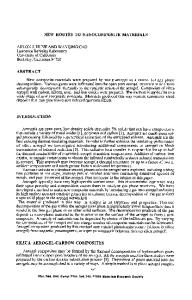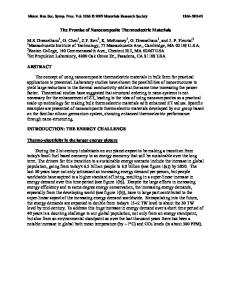New microstructural model of polymer-ceramic nanocomposite materials
- PDF / 310,103 Bytes
- 6 Pages / 612 x 792 pts (letter) Page_size
- 3 Downloads / 461 Views
MATERIALS RESEARCH
Welcome
Comments
Help
New microstructural model of polymer-ceramic nanocomposite materials C. E. Becze and G. Xu Department of Materials Science and Engineering, McMaster University, Hamilton, Ontario, Canada L8S 4L7 (Received 20 November 1995; accepted 29 July 1996)
Organoceramics are a new class of polymer/ceramic nanocomposite materials where polymer chains are molecularly mixed with the ceramics. A structural model for poly(vinyl alcohol) organoceramic nanocomposite materials proposed by Messersmith and Stupp [J. Mater. Res. 7, 2599–2611 (1992)] claims that polymer chains disperse in the interlayers of the ceramic precursor, causing a broadening of the basal plane spacing. The present research revealed this basal plane broadening does not exist. A new model was constructed where the polymer acts as a template for the ceramic microcrystals ˚ The ceramic microcrystals (hydrogen to nucleate and grow to reach a size of 20 A. bonded to the polymer) further agglomerate and grow to the resulting rosette morphology, whereby the polymer is molecularly dispersed on the nanoscale throughout the ceramic.
I. INTRODUCTION
Composite materials have been explored to a great degree because of the necessity to engineer a material with specific properties. They are achieved by selecting suitable materials with the best desired attributes and combining them into one composite material. Recently, research has shown promise in the development of new polymer-ceramic nanocomposite materials called organoceramics whose microstructure, as well as physical and chemical properties, are markedly different from those of the precursors.1–4 These novel properties are achieved by the molecular dispersion of polymer macro molecules into a ceramic host on the atomic scale.1–5 The synthesis of this organoceramic requires a water soluble ceramic precursor that is known to form complexes with organic molecules, tetracalcium aluminate hydrate (TCAH) [CA2 Al(OH)6 ? nH2 O], and poly(vinyl alcohol) (PVA), a water soluble polymer. The two reagents are coprecipitated to form organoceramic nanocomposite materials.1 The procedure, in an uncontrolled way, mimics nature in the biomineralization process.5–7 However, the exact atomic structure of this material has yet to be resolved. Messersmith and Stupp1 have proposed a model for the nanodispersion of polymer macro molecules into the interlayers of the ceramic host. These interlayers are composed of hydrated layers, which are thought to be suitable sites for the dispersion of the polymer macro molecules. This ordering of the polymer chains in the galleries of the ceramic host would broaden the basal plane spacing, shifting the (0, 0, 2) plane centered at 11.8± 2u to a lower Bragg angle of approximately 5.8± 2u.1 Unless this shifting of the (0, 0, 2) plane is reproduced or confirmed, the above 566
http://journals.cambridge.org
J. Mater. Res., Vol. 12, No. 2, Feb 1997
Downloaded: 14 Mar 2015
picture of ceramic ordering and assembly of polymer chains in the fashion as stated above i
Data Loading...











